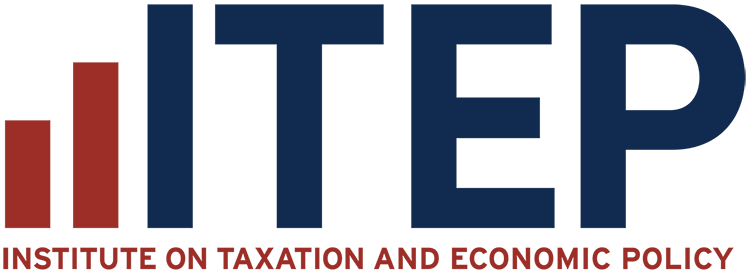
ITEP Work in Action
Kentucky Center for Economic Policy: New Report Shows Kentucky’s Tax System Worsens Income Inequality
October 18, 2018
In Kentucky, the income inequality that exists between our poorest and wealthiest residents is magnified by the structure of our tax system. And thanks to the new tax law enacted by the 2018 General Assembly, that problem is getting worse.
West Virginia Center on Budget & Policy: West Virginia’s Upside Down Tax System Grows Inequality
October 18, 2018
State and local tax systems can be effectively used to boost economic opportunity, create broadly shared prosperity and build equitable state economies. But in most states, including West Virginia, tax systems are upside down and are making inequality worse, as a new report from the Institute on Taxation and Economic Policy (ITEP) shows.
Seattle Met: Report: Washington State Taxes Are Still the Most Inequitable in the Country
October 18, 2018
In Washington state, the less money you make, the larger your percentage of income goes toward taxes. A study from the Institute on Taxation and Economic Policy released on Wednesday concludes that Washington state still has the most regressive taxes in the U.S., meaning the poorest households pay a disproportionate amount of taxes compared to the richest households in the state.
NJ Spotlight: New Jersey’s Tax System Ranked Among Fairest in the Country
October 18, 2018
A report on the fairness of state and local tax policy that was released yesterday by the Washington, D.C.-based Institute on Taxation and Economic Policy ranked New Jersey among the U.S. states with the most equitable tax systems. Read more
Message-Inquirer: Tax Study Explores ‘Who Pays?’ in Kentucky
October 18, 2018
A new study from a national economic policy research group suggests Kentucky’s tax structure has become less equitable since the last General Assembly's tax reform legislation, putting more tax obligation on poor and middle-class Kentuckians.
Providence Business Journal: Study Finds the Wealthy Pay a Lesser Share of Their Income Taxes in R.I.
October 18, 2018
The greater your income in Rhode Island, the less of it you pay in state and local taxes, a new study finds. The top one percent of Rhode Islanders [those making more than $467,700 a year] pay 7.9 percent of their income in total state and local taxes, while the bottom 20 percent [those earning less than $21,700 a year] pay 12.1 percent of their income in such taxes.
KRWG: Lowest-Income Taxpayers in NM Pay 1.8 Times the Tax Rate Paid by the Richest New Mexicans
October 18, 2018
Commentary: A new study released by the Institute on Taxation and Economic Policy (ITEP) finds that the lowest-income New Mexicans pay a state and local tax rate that is almost double what the state’s wealthiest residents pay as a share of their income.
Rutland Herald: In All Fairness
October 18, 2018
Anti-tax advocates across the country and in Vermont continue to push for policies that reduce tax rates for the wealthy and businesses, the report finds. However, a movement is growing in opposition to this agenda, as the public realizes that tax cuts for the wealthy and corporations mean less money to fund the things that benefit everyone: schools, parks and public spaces, infrastructure, public safety and other basic services.
NJ BIZ: Report: NJ’s Top Earners Pay Lower Tax Share Than Middle-Income Families
October 17, 2018
New Jersey’s top earners enjoy vastly more wealth than the majority of New Jersey residents but pay a much lower percentage of taxes than middle-income families in the state. That’s according to a nationwide analysis released Wednesday by New Jersey Policy Perspective and the Institution of Taxation and Economic Policy.
Big Island Now: STUDY: Hawai‘i’s Low-Income Taxpayers Carry 2nd Highest Tax Rate
October 17, 2018
The main cause of the heavy tax burden on those making the least in Hawaiʻi is the General Excise Tax (GET). Families in the lowest fifth spend 10.5% of their meager incomes on the GET, while the top 1% spend only 1.2% of their large earnings. In other words, those at the bottom spend 8.75 times more of their income on the GET than do those at the top.
DC Fiscal Policy Institute: Narrowing Income Inequality Through the Tax Code
October 17, 2018
DC’s tax system stands out in two key ways, according to a new analysis on how state tax policies affect families at different income levels. First, taxes on DC families living on very low incomes–below about $24,000 a year–are lower than in any state in the U.S. That good news is due primarily to income and property tax credits targeted to help residents working hard to make ends meet. But the analysis shows that families with incomes just above that level pay the same share of their income in DC taxes (income, sales, and property taxes) as the District’s wealthiest…
Maine Center for Economic Policy: Maine Still Has Work to Do in Building a Balanced and Adequate Tax Code
October 17, 2018
Building an inclusive economy requires tax policy that meets two conditions. The first is that those with the most are asked to pay more, or at the very least pay as great a share of their income in taxes as everyone else. The second is that enough shared resources are raised through the tax code to invest adequately in foundations of a strong economy including good schools, access to health care, and safe and modern infrastructure.
Iowa Fiscal Partnership: Tax Inequity: Iowa’s Continuing Story
October 17, 2018
Iowa taxes its middle- and low-income families more as a share of income than it does wealthy families, a long-term trend worsened by the 2018 tax overhaul. The latest “Who Pays” report by the Washington-based Institute on Taxation and Economic Policy (ITEP), again shows the effect of sales taxes and property taxes on lower-income households tilts Iowa’s overall tax system so the poorest pay the highest percentage in taxes.
New Mexico Voices for Children: New Analysis: Lowest-Income Taxpayers in NM Pay 1.8 Times the Tax Rate Paid by the Richest New Mexicans
October 17, 2018
“Taxes are the way we accomplish great things for our state – build our schools and infrastructure, provide health care and public safety, and more,” said James Jimenez, executive director of New Mexico Voices for Children, which partnered with ITEP on the report release. “These systems and services underpin our economy and improve our quality of life. We all need to do our part to support them, but our current state tax system ensures that those who can afford to pay the most actually pay the least.”
Michigan League for Public Policy: News Flash: Michigan Taxes Are Still Upside-Down
October 17, 2018
While no news is often regarded as good news, in this case, it’s not. Michigan’s tax structure is still highly regressive, and taxes Michiganders with low incomes at a higher rate than Michigan’s wealthiest residents, according to a report by the Institute on Taxation and Economic Policy.
Oregon Center for Public Policy: Oregon Taxes Fall Hardest on Those Who Earn the Least
October 17, 2018
Oregon’s poorest families pay more in taxes as a share of income than any group of taxpayers in the state, while the richest Oregonians pay the smallest share of any group. That is the conclusion of a new report by the Washington, D.C.-based Institute on Taxation and Economic Policy (ITEP).
Arkansas Advocates for Children and Families: Arkansas Tax System Worsens Economic Inequality
October 17, 2018
Another key driver of inequality in Arkansas’s tax system is the preferential treatment given to capital gains income. Currently, half of all capital gains income is exempted, or ignored, from income taxes even though nearly no one makes a significant share of their income through capital gains (except for the top 1 percent). According to a report from the Congressional Budget Office, capital gains make up 38 percent of the income of the richest 1 percent of households in this country, compared to just 5 percent of the income for the poorest households.
Minnesota Budget Project: Minnesota Ranks High for Tax Fairness in 50-State Study
October 17, 2018
In an era of income inequality and growing concentration of wealth, a new 50-state study released today analyzes whether state tax systems make income inequality better or worse. The Institute on Taxation and Economic Policy (ITEP) finds that nearly every state fails basic measures of fairness, but Minnesota is among a small number of states where income inequality is reduced by state tax policy.
NC Policy Watch: Low-income Tax Payers in NC Pay More of Their Income in State and Local Taxes Each Year Than the Richest Taxpayers
October 17, 2018
Sales taxes play a critical role in the regressive and consequently inequitable nature of the North Carolina tax system. Like most other states, North Carolina relies on sales and excise taxes (30.7% of the 2018-2019 approved budget) as a primary mechanism to raise revenue. However, in North Carolina, sales and excise taxes are the most regressive taxes when compared to income and property taxes. The lowest 20% of North Carolina workers pay 6.1 percent in sales taxes as a percentage of their income while the top 1 percent pays less than 1 percent in sales taxes as a percentage of…
Alabama Arise: The Less You Make, the More You Pay: Alabama’s Taxes Remain Upside Down
October 17, 2018
Low-income Alabamians pay twice as much in state and local taxes as a share of their income compared to the state’s wealthiest residents, according to a study released Wednesday, Oct. 17, 2018, by the Institute on Taxation and Economic Policy (ITEP), a nonprofit research organization based in Washington, D.C. The study, Who Pays?, analyzes major state and local taxes in all 50 states, including personal and corporate income taxes, property taxes, sales and other excise taxes.
Uprise RI: Low-income Taxpayers in Rhode Island Pay Over 50 Percent More in Taxes Than the Wealthiest
October 17, 2018
There’s a practical reason for Rhode Island and all states to be concerned about regressive tax structures, according to ITEP. If the nation fails to address growing income inequality, states will have difficulty raising the revenue they need over time. The more income that goes to the wealthy (and the lower a state’s overall tax rate on the wealthy), the slower a state’s revenue grows over time.
Oregon Center for Public Policy: Undocumented Workers in Multnomah County Pay Millions in Oregon Taxes
October 17, 2018
An estimated 27,000 undocumented Multnomah County residents pay nearly $19 million annually in state and local taxes. For perspective, that is enough to hire 217 teachers. Read more here
Oregon Center for Public Policy: Undocumented Workers in Washington County Pay Millions in Oregon Taxes
October 17, 2018
An estimated 27,000 undocumented Washington County residents pay more than $20 million annually in state and local taxes. For perspective, that is enough to hire 232 teachers. Read more here
Oregon Center for Public Policy: Undocumented Workers in Marion County Pay Millions in Oregon Taxes
October 17, 2018
An estimated 18,000 undocumented Marion County residents pay nearly $14 million annually in state and local taxes. For perspective, $14 million is enough to hire 157 teachers. Read more here
Arkansas Times: Report: Arkansas Taxes Unfair ….. To the Poor
October 17, 2018
Arkansas Advocates for Children and Families is highlighting a new report relevant to ongoing legislative discussions of "tax reform." It does not suggest the problem is taxation on the rich.
Advocates and policymakers at the state and federal levels rely on ITEP’s analytic capabilities to inform their debates on proposed tax policy changes. In any given year, ITEP fields requests for analyses of policies in 25 or more states. ITEP also works with national partners to provide analyses of federal tax policy proposals. This section highlights reports that use ITEP analyses to make a compelling case for progressive tax reforms.
